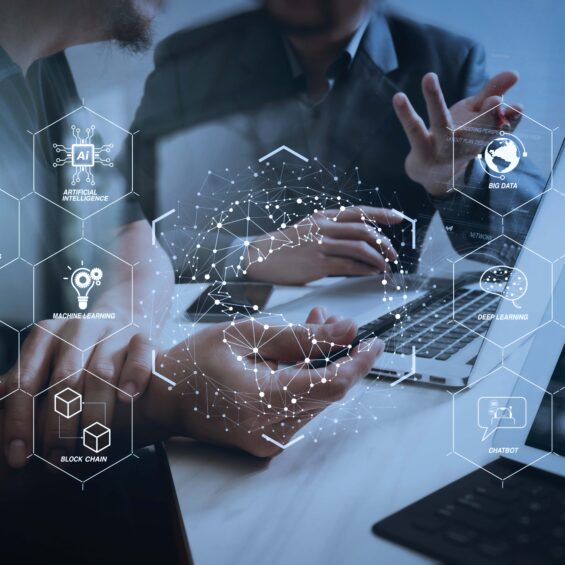Quickly, we are entering into an age where the concepts once reserved for sci-fi movies are now seeming slightly more possible. While it is very clear that we are far from realising all-knowing AI systems (AKA General AI), this should not detract from the scale of the technology being developed. The advancements within systems that can perform a single task extremely well have been great to see.
Similarly, AI has been hugely disruptive in the realm of healthcare. Diagnostics, remote patient monitoring and hospital logistics are just three areas where AI has made impact by leveraging the wealth of available data. Healthcare has proved to be a prime recipient for AI intervention due to the abundance of data that is collected, an almost a 1500% increase over the past seven years. Therefore, as developments such as the Apple watch makes healthcare data even more abundant, we are beginning to see even more opportunity for health AI growth. To distil these two complex fields, we will explore two questions:
- What is happening?
- What are the difficult questions that need to be tackled?
What is happening?
Below are three prominent spheres where AI is causing disruption within healthcare. AI has the potential to do the same tasks as humans but efficiently, faster and at a lower cost. However, the real value is not found in replacing doctors and medical personnel but in using these systems to augment their capabilities and free up resources to focus on only the most critical tasks.
Diagnosis
The first area that readily comes to mind at this health-AI intersection is its capabilities in assisting with the diagnosis of health conditions. Machine learning, the branch of AI which is responsible for lots of recent developments, finds patterns in data extremely well. This pattern recognition aptitude then directly translates into an ability to synthesise numeric and even graphical health data and make predictions.
According to PwC research, IBM’s Watson for Health and Google DeepMind health are major drivers in this area. For example, in cancer diagnosis, studies have found AI systems that achieved a breast cancer detection accuracy comparable to an average breast radiologist. Furthermore, machine learning and systems neuroscience are also being combined to build algorithms into neural networks that mimic the human brain.
Excitingly, a plethora of start-ups are also finding success in applying these novel techniques towards diagnosis. One such is named, Lucida Medical, who utilise machine learning on MRI scans to accurately support cancer screenings.
Personalised medicine and healthcare
Next, we turn our attention to personalised healthcare. The ability to provide tailored healthcare at the individual level is something largely unseen. At most, populations are broken into subgroups based on gender and ethnicity but as is the case with all groups, the mean is not always representative – there are always outliers.
With the onset of cheaper genome sequencing alongside wearable IoT devices (e.g. smart watches), personalised healthcare can really become a reality. However, there is a huge amount of data required to bring this about and this is where AI comes to play. For example, clustering algorithms can create drug recommendations based on similar patients who responded well to the treatment plan. However, these recommendations could be made based on the unique genomic profile of individuals as opposed to macro identifiers such as ethnicity.
Patient monitoring and care
Finally, we turn to the field of patient monitoring which can be both real time or post data collection. The use of wearable IoTs and other remote monitoring tools allow for a constant stream of data which can be input into an AI system to predict conditions before they manifest. This is especially valuable given the number of complications that arise once a patient is discharged from hospital care. By incorporating hardware and cloud computing advancements with these novel algorithms, vital signs can be measured and used to predict health deterioration ahead of time.
iRhythm is a company which does just that. The company uses data from its remote monitoring devices to predict heart conditions before they occur, and its service has already helped over two million patients.
What are the difficult questions that need to be tackled?
With all this advancement, it’s easy to only see the bright side of this technology. However, companies such as OpenAI have developed systems so advanced that they have been unwilling to share them out of fear of what would be made possible by bad actors. It is essential for certain key questions to be answered before we see mass adoption of this technology.
How to overcome the implementation gap?
The implementation gap refers to methodologies and technology that have been proven effective in controlled environments but are not widely adopted due to a failure to navigate the broader macroeconomic landscape or the nuances of a certain industry. This gap is significant in healthcare as fewer than 50% of clinical innovations make it into general usage. Therefore, the need to overcome this gap is clear. A big driver to overcome this gap in healthcare is the concept of interpretability, how did the system arrive at the conclusion it did? Increasing interpretability and moving away from the so called “black box” approach is vital for mass adoption.
How do we combat bias within datasets?
The field of machine learning is exactly as the title suggests, it is a machine that is learning based on the data that it receives. This means that if the input data is biased, e.g. too few samples of a minority group, it will negatively affect its performance on that group at deployment. While medical data is abundant within healthcare, gaining access to that data is slightly more difficult due to data privacy laws. These laws have meant that creative approaches have been made to ensure that algorithms are trained on non-biased datasets.
One such example is from Microsoft. Microsoft have developed Federated Learning with a Centralized Adversary (FELICIA) that allows hospitals to share medical image datasets without violating patient privacy. It achieves this by generating a synthetic dataset utilising FELICIA and the contributions to FELICIA will come from hospitals globally. This approach combats local population bias as data can be shared across many regions and in theory this will lead to better health diagnostics for all.
The two above questions are just two of many that will be tackled in the quest for mass adoption of AI within the healthcare space. As the level of education on the benefits and importantly the limitations of AI rises, the further deployment of these systems within healthcare seems inevitable. I for one am excited to see the benefits it can have for both individual and public health.




